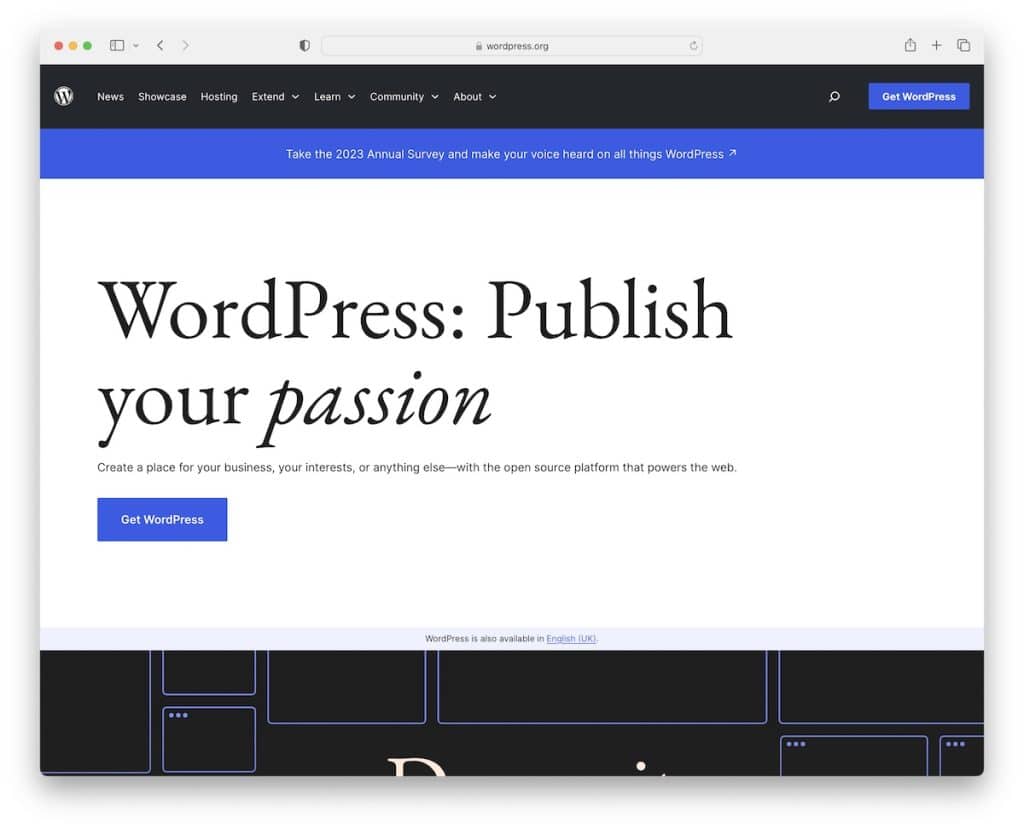12 Best Open Source CMS In 2023
Are you ready to dive into the wonderful world of open source CMS?
Think of it as the ultimate digital playground where your ideas swing, slide, and seesaw into reality – without costing you a penny.
Open source CMS software has become a beacon of flexibility, innovation, and community-driven excellence.
These platforms make the web development process accessible and affordable, pushing the envelope of what is possible through collaboration and shared knowledge.
We’ll discuss the top open source CMS platforms making waves this year. Whether you’re building your first website or looking to switch up your digital game, there’s something here for everyone.
From the giants everyone’s heard of to the hidden gems waiting to be discovered, we’ll explore what makes each one special.
Let’s find your CMS match!
This post covers:
The Best Open Source CMS Software
Choosing the right open source CMS can make all the difference in your web journey.
It’s all about finding that sweet spot where ease meets power – a place where you can express yourself, manage content like a boss, and not get tangled in techy knots.
Think about what matters to you most. Is it the simplicity of a drag-and-drop editor? Maybe it’s the flexibility to grow from a blog to a bustling online store? Or could it be a vibrant community to swap tips with?
For the ultimate experience, look for a CMS with intuitive design, robust features, and the freedom to customize until your heart’s content.
Remember, the best CMS makes you say, “Yep, that’s my kind of tool!”
And in the list below, we included something for everyone. Let’s GO!
Note: You might also like to check our extensive CMS market share statistics.
1. WordPress
When it comes to open source CMS options, WordPress stands out for its straightforward approach that caters to beginners and pros alike.
Here’s the straight talk on WordPress: It’s not just user-friendly; it’s powerfully intuitive.
You don’t need to be a tech whiz to get your site up and running. The setup process is simple, and managing content is as easy as drafting an email.
Need a specific look or functionality? WordPress has a vast repository of themes and plugins, meaning you can find a tool for anything without writing a line of code.
The true beauty of WordPress lies in its scalability. Start with a small personal blog – no problem. Grow to a bustling online store – WordPress can scale with you, ensuring your site is as dynamic as your ambitions.
And let’s talk about community. It’s enormous and ever-helpful. Run into a snag? The solution is likely a quick forum search away. Plus, regular updates mean you’re always equipped with the latest web technologies.
WordPress provides a reliable, flexible foundation for whatever you’re building online.
Key Features of WordPress:
- Intuitive dashboard that allows users to easily navigate and manage their content. This makes it an excellent choice for beginners and advanced users alike.
- With 50,000+ plugins in the official directory, WordPress lets you easily extend your site’s functionality. Adding an SEO tool, a contact form, or an eCommerce solution is a piece of cake.
- There are 1,000s of themes available that allow you to change the design of your site quickly. Many of these are customizable without touching a single line of code.
- Being the most popular CMS in the world (see our WordPress statistics), WordPress has a massive community. This means extensive forums, tutorials, and meetups to help you troubleshoot issues or learn how to do more with your site.
- WordPress is designed with search engine optimization (SEO) in mind. It offers clean, search-friendly code, and with plugins like Yoast SEO, you can further optimize your site for better rankings.
Best for:
WordPress is ideal for individuals and businesses seeking a user-friendly platform that offers flexibility for growth and customization.
It’s perfect for bloggers, small to medium-sized businesses, and online stores that want to leverage a vast array of plugins and themes to tailor their online presence.
Additionally, it benefits those who value a strong community support network, providing assistance and resources for users at all skill levels.
Pricing: Completely free, but the user must pay for hosting and domain name (and themes and plugins if choosing premium ones).
2. Ghost
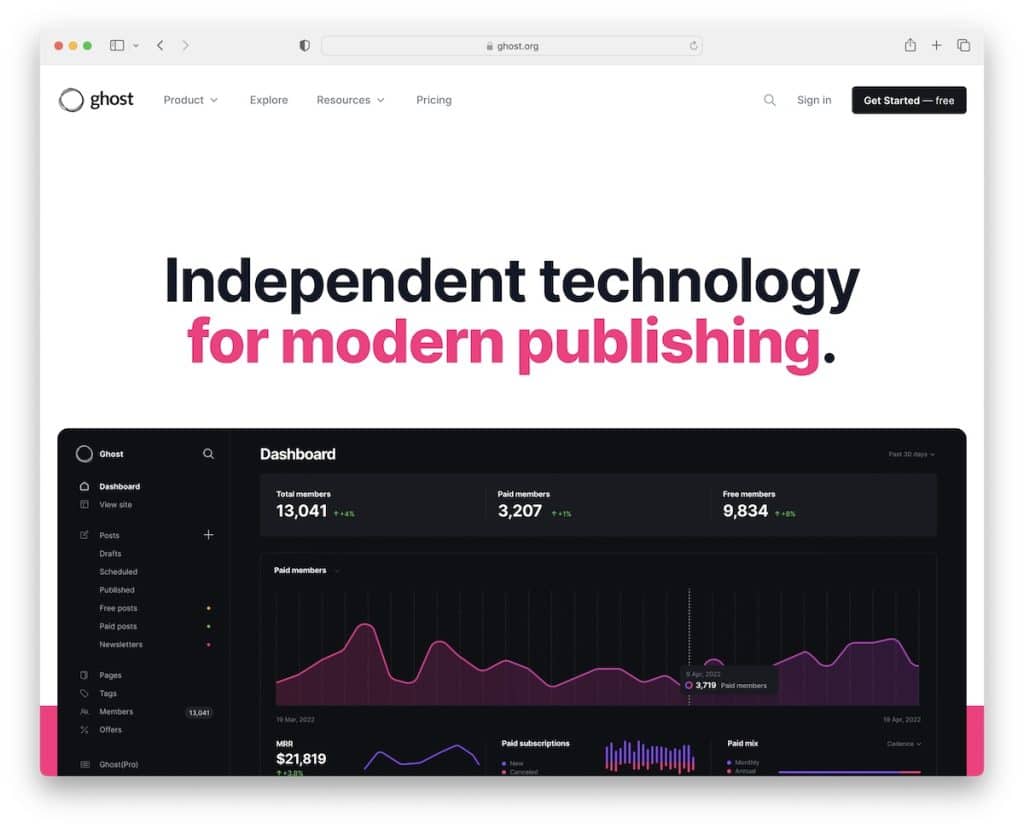
Let me introduce you to Ghost if you’re all about sleek, fast, and focused content delivery. It’s the cool, minimalist cousin in the open source CMS family.
Ghost is designed with one thing in mind: Publishing.
It’s clean, modern and gets your words to the screen without any fuss. Perfect for bloggers and writers, Ghost offers a clutter-free interface that prioritizes your content.
It’s lightning-fast, SEO-ready out of the box, and the user experience is so smooth, it’s like gliding on a freshly Zamboni’d ice rink.
Plus, with Ghost, you’re in a community passionate about good design and even better writing.
So, if you’re looking to turn readers into fans, Ghost might just be your go-to publishing partner. Ready to let your stories take center stage? Ghost is ready for all your ideas.
Key Features of Ghost:
- Editor that’s a writer’s dream, allowing for quick formatting and intuitive writing without the clutter of unnecessary tools.
- Built-in SEO settings and social media integration without the need for additional plugins. This makes it easier to reach your audience effectively.
- With a focus on speed and performance, Ghost is built on Node.js, ensuring your content loads quickly. (It improves user experience and site rankings.)
- Clean, minimalist interface that emphasizes content creation and presentation, promoting a distraction-free environment for writers and readers.
- Native support for membership and subscription business models allows you to monetize your content and manage subscribers with ease.
Best for:
Ghost is best suited for writers, bloggers, and publishers prioritizing a clean, focused writing experience and streamlined content management.
It’s a top choice for individuals or organizations that aim to monetize their content through memberships and subscriptions, thanks to its built-in tools.
Furthermore, it appeals to users who value speed, SEO, and a modern, uncluttered interface that allows their text to shine.
Pricing: Ghost is free to download and use, but you can also opt for a paid managed solution, starting at $9/month.
3. Craft CMS
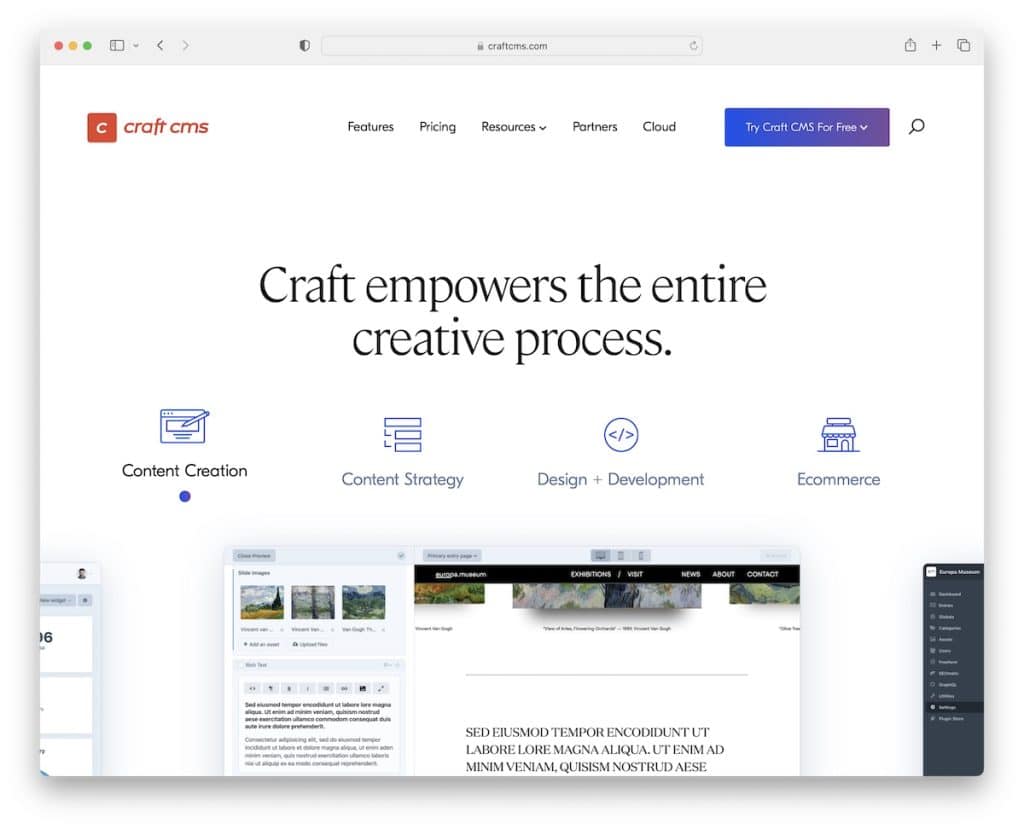
Ever find yourself wishing for a CMS that’s as easy to use as it is powerful? That’s Craft CMS for you.
Craft CMS is all about flexibility and attention to detail. It’s a dream for developers and designers who love to create a custom-tailored web experience.
What’s special about Craft? It treats your content with the care it deserves, offering a sleek control panel that’s a joy to use. You won’t find any bloat here (my favorite part) – just the features you need to make a website that’s truly yours.
And the live preview feature? It shows you exactly how your content will look live as you create it.
Perfect for businesses and creatives eager to stand out, Craft CMS is like your personal workshop, stocked with every tool you could imagine.
Build a bespoke site (online shop, too) that meets all the modern standards with amazing management control.
Key Features of Craft CMS:
- Live preview feature allows you to see how your changes will look in real-time before you push them live.
- Matrix field lets you create a custom block-based content field for flexible content modeling and design within your pages.
- You can manage multiple websites with different languages and content structures from a single Craft CMS installation.
- While Craft CMS has extensive built-in capabilities, you can also extend its functionality with various plugins available in the Craft Plugin Store.
Best for:
Craft CMS is best for web developers and designers who crave the ability to create bespoke websites with a highly customizable and flexible content management framework.
It’s ideal for businesses and agencies that need a tailored user experience and unique functionality that isn’t typically available with off-the-shelf solutions.
Pricing: Craft CMS has a limited free forever Solo plan and pro plans that start at $299 per project.
4. Grav
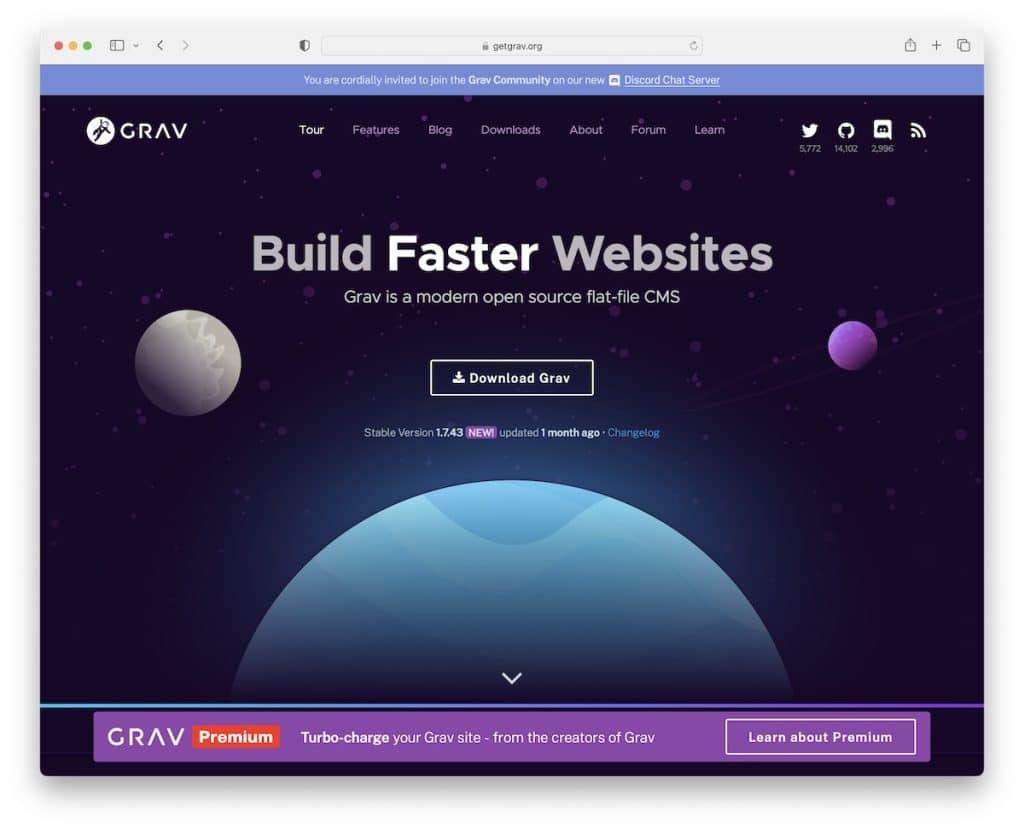
Dive into the world of Grav, the open source CMS all about simplicity and speed.
Think of Grav as that lightweight, high-performance sports car among CMSs. It gets you where you need to go, fast, without any of the bulk that slows you down.
Grav doesn’t need a database to power your site, so installation is a breeze, and managing your content is as simple as editing a text file.
What’s super cool about Grav? It’s all about being super intuitive.
The admin interface is a delight, making the content management task feel less like work and more like play. And for developers, Grav’s modern architecture and powerful templating offer the freedom to create without constraints.
Ready to zip through the web with ease? Grav’s got the keys!
Key Features of Grav:
- Grav is a flat-file CMS that doesn’t use databases to store content. All data is stored in files, which makes it incredibly speedy and easy to set up.
- It uses Markdown for content creation, allowing for quick and easy editing of your content without needing a fancy editor.
- Utilizes the Twig templating engine, making it highly flexible for designers and developers to create custom themes and modular templates.
- Sophisticated caching system to deliver content at high speeds, which is a big plus for performance optimization.
Best for:
Grav is best suited for developers, designers, and content creators who prioritize speed, simplicity, and the need for a lightweight CMS without the complexity of a database.
Additionally, Grav’s flat-file nature and markdown-based content management make it a favorite for tech-savvy users who prefer a straightforward, file-based approach to website structure and deployment.
Pricing: There is no cost associated with downloading and using the standard version of Grav.
5. Joomla

Joomla is the powerhouse CMS that gives you the best of both worlds.
With Joomla, you get an open source solution that’s robust and user-friendly, perfect for those who want a bit more oomph than the basics but without the steep learning curve of more complex systems.
Joomla is like that multi-tool gadget you can’t do without. It’s incredibly versatile, whether you’re building a small business website, a personal blog, or a large-scale eCommerce platform.
With its vast library of extensions, you can customize to your heart’s content while easily navigating its straightforward back-end.
And the community! It’s large, supportive, and always there to lend a helping hand.
Joomla strikes a beautiful balance between power and simplicity. It gives you the confidence to create and manage a website (or a few) that’s as feature-rich as it is gorgeous.
Key Features of Joomla:
- Comprehensive user management system with multiple user groups and permissions. This allows for detailed access control for different types of users, from administrators to editors and beyond.
- Joomla can be expanded to fit virtually any website need, from simple designs to complex functionalities, with 1,000s of plugins and extensions available.
- Joomla templates are easy to install and customize. You can change the look and feel of your site with relative ease and often without needing to touch the code.
- You’ll also enjoy 100% mobile-friendliness and better search engine optimization straight out of the box.
Best for:
Joomla is ideal for small to medium-sized businesses, non-profits, and organizations that require a website with a structured hierarchy and varied content types.
It’s worth mentioning that Joomla is best for individuals with some web development knowledge who want to build a feature-rich site with room to grow and scale.
Pricing: Joomla is entirely free to use, but like with other similar open source CMS tools, fees apply for hosting, domain, premium templates, etc.
6. PrestaShop

Step right up and discover PrestaShop, the open source CMS that’s a shopping cart powerhouse with a heart.
Why go with PrestaShop?
Because it’s all about making eCommerce easy.
You get an intuitive interface that removes the tech stress of setting up shop. Plusa, a collection of customizable PrestaShop themes and modules ensures your store looks and runs just how you want it.
Whether launching your first product or expanding your digital empire, PrestaShop is the trusty sidekick to make your online store a roaring success.
So why wait?
But if you need more solutions, don’t miss our list of the best eCommerce CMS solutions.
Key Features of PrestaShop:
- Flexible and comprehensive product management system for adding and managing a wide range of products, with advanced features like product comparisons, wishlists, and layered navigation.
- It supports multiple languages and currencies, making it easier to sell to customers worldwide and providing a localized shopping experience.
- Built-in marketing tools, including promotional offers, coupon codes, email marketing integrations, and more, to help you attract and retain customers.
- The platform also offers detailed analytics and reporting features that give insights into sales, customer behavior, and more. (Make informed decisions to grow your business.)
Best for:
PrestaShop is best suited for entrepreneurs and businesses of all sizes looking to create an online store without a hefty initial investment.
Its user-friendly interface and rich feature set cater to those who want an out-of-the-box eCommerce solution with room for customization.
Pricing: PrestaShop is free to use, without any hidden fees. But you’ll need to pay for hosting, domain name and other (premium) design elements to run an eCommerce site successfully.
7. Bolt
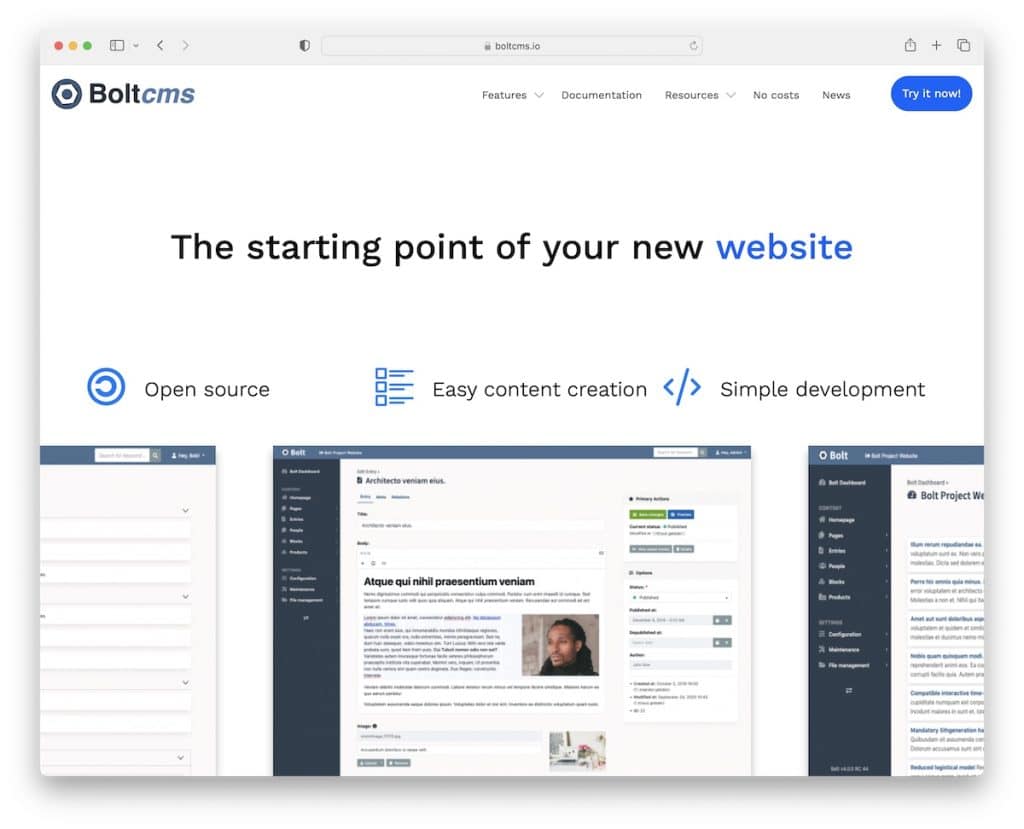
Bolt isn’t just another CMS; it’s a Symfony 5 powerhouse, which means you get all the robustness of this fantastic framework. (This makes extending your website’s capabilities a breeze.)
With Twig for your templates, you’re using a tool developers adore for its flexibility, speed, and security. Crafting the HTML for your masterpiece is as simple and enjoyable as sketching on a blank canvas.
And when it comes to going global, Bolt’s built-in internationalization is a game-changer. A single line of code is all it takes to reach a multilingual audience.
Need an API? Bolt’s got you covered with RESTful and GraphQL APIs right out of the box.
And let’s not forget about content: Bolt comes with dummy content generation that’s as easy as pie, ensuring your project looks top-notch.
But the real cherry on top? The rich content editors, Article and Redactor, are fully licensed for Bolt, making content creation and editing effortless.
Key Features of Bolt:
- A robust, high-performance foundation (Symfony 5) that allows for extensive scalability and customizability with Symfony extensions.
- Bolt utilizes Twig, the flexible, fast, and secure templating engine, making it easy to create and manage your site’s layouts and designs.
- Supports multilingual content management, enabling field-level control for localized translation and a global reach for your site.
Best for:
Bolt is an ideal open source CMS for developers and web designers who appreciate the blend of straightforward content management with the robustness of a Symfony application.
It’s perfect for those who need flexibility in design and functionality but want to avoid the bloat of more cumbersome systems.
Pricing: Bolt is free whether you’re building a personal project or sites for clients.
8. OpenCart

Have you been looking for a CMS that turns setting up an online store from a chore into a charm?
Let’s discuss OpenCart, your go-to open source buddy for everything eCommerce. It’s packed with all the features you need and none you don’t.
OpenCart stands out with its user-friendly dashboard that makes managing your products, orders, and customers a breeze.
Setting up is so simple so that you can focus more on the important things – growing your business! Plus, with many OpenCart themes and extensions, you can dress up your store to reflect your style and expand its functionality as your business blossoms.
And the community? It’s like a bustling bazaar, brimming with fellow merchants, developers, and designers all ready to exchange tips and tricks.
OpenCart is not just about building an online store; it’s about joining a vibrant community cheering for your success.
Key Features of OpenCart:
- Straightforward, intuitive admin dashboard that simplifies the management of products, customers, orders, and other sales-related tasks.
- It provides the ability to manage multiple stores from one admin interface, making it easier to run several shops with different designs, products, and customers.
- The platform includes SEO tools to help optimize your product pages for search engines, improving visibility and organic traffic.
Best for:
OpenCart is ideal for small to medium-sized businesses that want a simple, no-frills approach to setting up an online store with ease.
The platform also caters to those who manage multiple eCommerce sites, offering features that streamline operations across diverse storefronts.
Pricing: OpenCart is a free open source CMS with an option for the Cloud service that starts at $59/month.
9. Concrete CMS
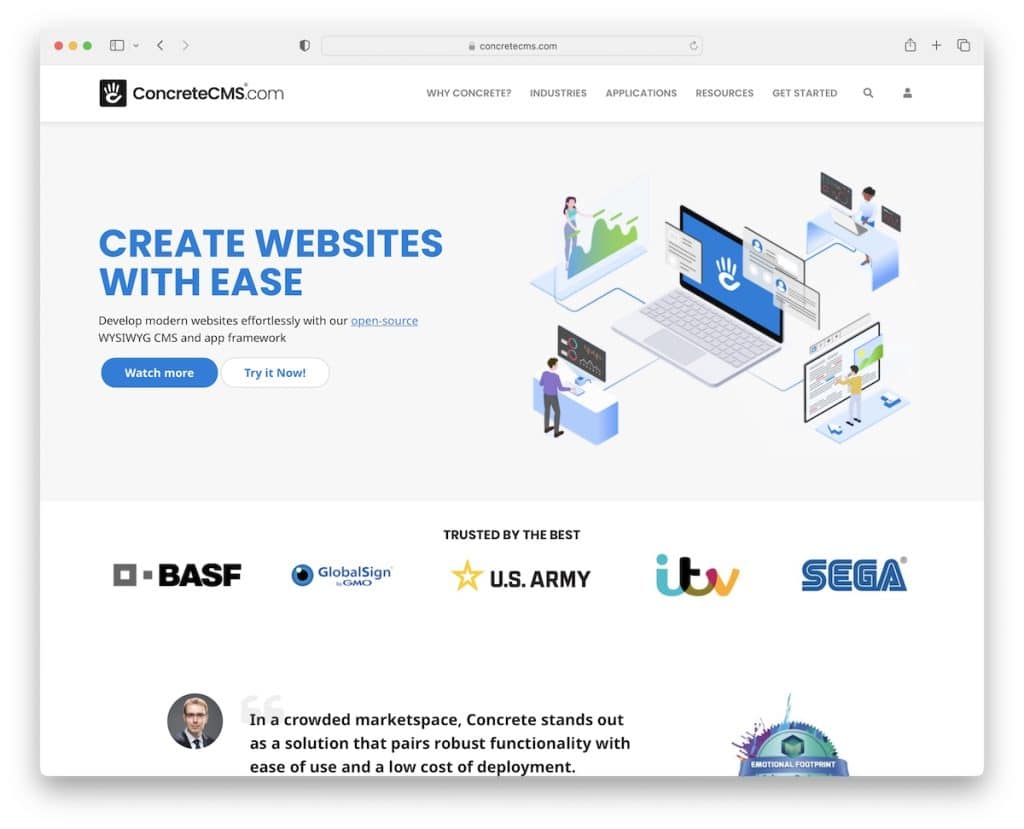
Concrete CMS is your one-stop shop for building robust websites that are easy to manage, even when things get complex.
With its WYSIWYG editor and drag-and-drop functionality, you can wave goodbye to coding and say hello to creativity.
The in-context editing means what you see is what you get – no more guessing games. And when it comes to extending your site’s capabilities, the sky’s the limit with heaps of add-ons and themes.
Your site will dazzle on every device, thanks to mobile-optimized, responsive designs. And with the Style Editor, you can tweak appearance to make your website look tailor-made without breaking a sweat.
Let’s not forget the marketing magic. Concrete CMS helps you connect with your audience and keep them engaged, from crafting forms and collecting data to integrated reporting and blogging tools.
Concrete CMS has your back with top-notch security features; if you ever need a hand, the no-hassle support and vibrant community are there for you.
Key Features of Concrete CMS:
- You can directly click and edit elements on your page, streamlining the web design process with its WYSIWYG (What You See Is What You Get) editor.
- Modular building with reusable stacks, templates, and blocks means you can easily create and maintain a consistent look across your website while keeping it responsive.
- It comes packed with tools to help you create forms, surveys and collect data, along with integrated reporting to analyze form results, survey data, user sessions, and more.
- Detailed user management and permissions settings allow granular control over who can view and edit different parts of your site, which is perfect for teams and collaborative environments.
Best for:
Concrete CMS is best for businesses and organizations that need a robust yet uncomplicated CMS to manage their online presence effectively without deep technical expertise.
Its intuitive editing and flexible design options make it ideal for those who value a hands-on approach to creating and updating their website in real-time.
Pricing: Concrete CMS is free and open source with optional paid plans ($16/month+) that include hosting.
10. Drupal

Let’s dive into Drupal, the open source CMS that’s about building websites while emphasizing digital experiences.
If you’re looking for a platform prioritizing security, Drupal stands tall as a fortress, keeping your user data safe like a treasure chest. And when your site traffic surges? Drupal performs like a champ, scaling with grace under pressure.
Dreaming of a global audience? Drupal’s multilingual powers make translations seamless, inviting users across the globe into your digital space. It’s committed to accessibility, too, ensuring that everyone, regardless of ability, can engage with your content.
Moreover, Drupal is a marketing maestro, fine-tuning your audience’s journey with intelligent automation and personalized experiences that resonate.
With Drupal, you’re not just creating content; you’re delivering it as a service, decoupling easily to weave your stories across platforms and channels.
Pro tip: Help yourself with these fantastic Drupal templates and save time.
Key Features of Drupal:
- Drupal has a strong reputation for being secure, with an active community constantly working to identify and patch any vulnerabilities, making it a trusted choice for high-stakes websites.
- Built to handle sites with heavy traffic and complex data structures, providing performance optimization features that help maintain speed and responsiveness as your site grows.
- Commits to web accessibility standards, ensuring that content is available to users with disabilities.
- The platform offers sophisticated personalization capabilities, utilizing user data to deliver individualized content experiences. This helps create a more relevant and engaging user journey for each visitor.
Best for:
Drupal is for those who require a highly customizable and scalable CMS to handle complex content structures and workflows.
It’s also ideal for folks who prioritize security and need a robust platform capable of creating sophisticated, personalized user experiences for a diverse, multilingual audience.
Pricing: Drupal doesn’t cost you anything. You’ll only need to pay for hosting, domain name, etc., like with other free open source CMS tools.
11. Microweber
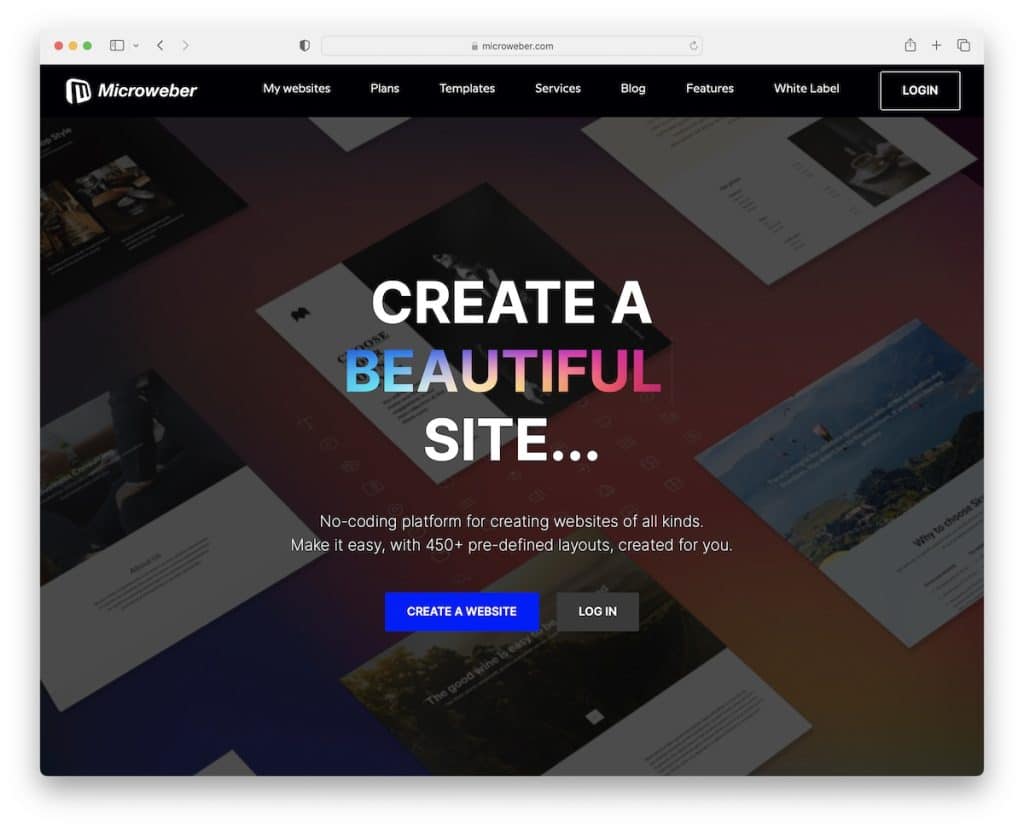
Welcome to the realm of Microweber, where creating a website is as easy and fun as a game of blocks with its revolutionary Live Edit feature.
Writing text, tweaking layouts, or adding content? It’s all happening live, right before your eyes, with no tech skills required.
Microweber’s admin panel is a cockpit of creativity. It offers real-time stats, dynamic page creation, and content management, which is a piece of cake.
Diving into eCommerce? Microweber has easy product uploads, streamlined order management, and a full suite of selling tools to keep your online store bustling.
And for bloggers, managing articles, moderating comments, and social sharing are all just a click away. Plus, with a wealth of modules and API integrations, your website can grow in functionality whenever needed.
Key Features of Microweber:
- Provides an easy-to-use, real-time editing experience, allowing users to update and see changes on the website instantly without switching between editing and preview modes.
- Offers preset layouts and the ability to boost website functionality with various custom modules tailored to specific needs.
- Ensures websites are automatically adjusted and optimized for a seamless experience on all (mobile) devices.
- A powerful admin panel that provides a great user interface, with tools to monitor website traffic, orders, and feedback as they happen.
Best for:
Microweber is ideal for entrepreneurs, small business owners, and freelancers who desire an intuitive platform for creating and managing a professional online presence without technical expertise.
Its user-friendly live editing, drag-n-drop functionality, and comprehensive eCommerce solutions ensure you get your project live online ASAP.
Pricing: Microweber allows you to build a small project for free. However, you can also choose between two premium plans: Personal ($8/month) and Business ($20/month).
12. Umbraco CMS
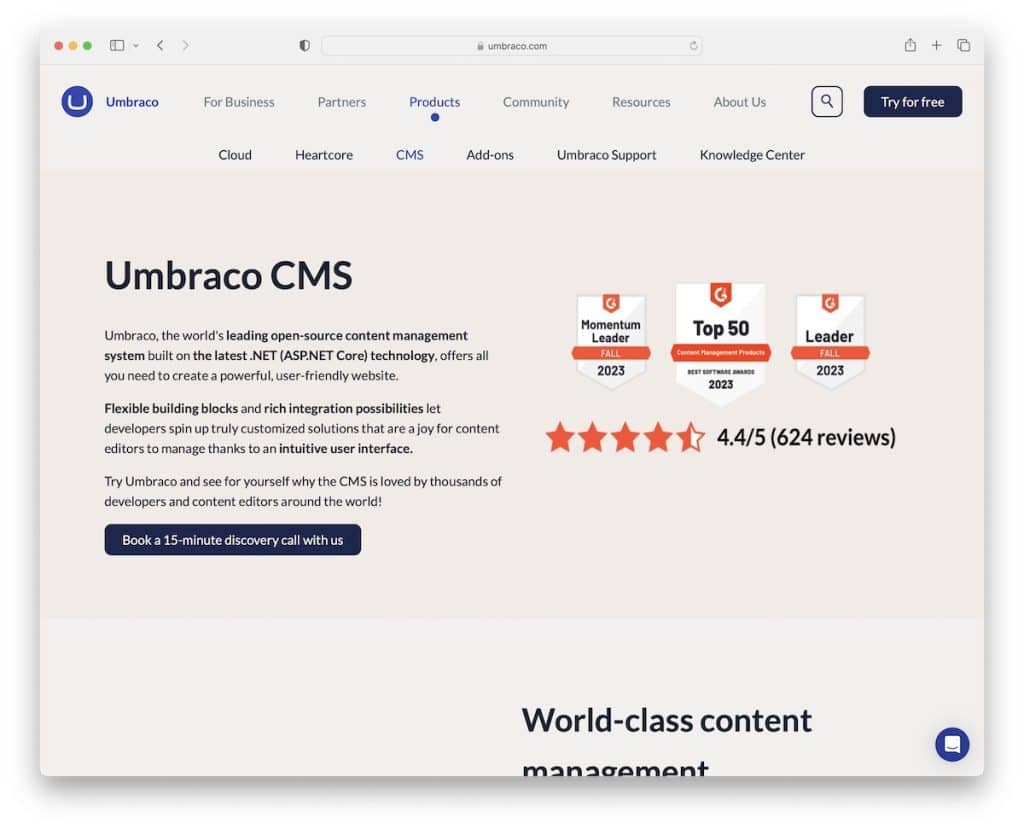
Welcome to the world of Umbraco CMS, where content management meets modern technology to create an editor’s playground and a developer’s canvas.
It’s a place where flexibility marries ease, offering you the building blocks to craft a website that’s a custom-fit suit, not off-the-rack.
With Umbraco, you’ll revel in world-class content management that feels like second nature. Dive into a media library that lets you upload and edit images and videos on the fly and organizes your media seamlessly.
For the developers in the house, Umbraco is your open-source oasis. Built on the robust .NET framework, it’s packed with powerful APIs, a service layer for scaling, and a Models Builder for swift rendering.
Plus, with its composable DXP approach, integration is a dream, letting you weave in everything from eCommerce to marketing tools.
So why not join the Umbraco universe, where the content is king, and the possibilities are endless?
Key Features of Umbraco CMS:
- Provides a stellar content management experience with an intuitive interface, allowing editors to easily publish and manage content, schedule campaigns, and more.
- Supports content creation in multiple languages to manage and publish content for a diverse, global audience across various channels.
- Offers developers a robust API, flexible content models, and extensive customization options, all with the benefits of the latest web development technology.
- Seamless integration with an array of 3rd-party tools and platforms, enabling a truly composable digital experience platform (DXP) that can adapt to any tech stack.
Best for:
Umbraco CMS is for those looking for a highly customizable and scalable open source CMS that seamlessly blends content management efficiency with developer flexibility.
It’s perfect for everyone who wants a user-friendly interface for content creators and robust .NET framework capabilities for developers to build feature-rich websites or applications.
Pricing: Umbraco CMS has a free open source version, but you can also opt for the paid Umbraco Cloud version with additional features.
What Is The Best Open Source CMS?
While all the open source CMS solutions that we included in the above list are fantastic, the three that stand out from the crowd are WordPress, Ghost and Craft CMS:
- WordPress stands out as the best for its unparalleled user base and ecosystem, offering 1,000s of themes and plugins that make it exceptionally versatile for any website, from blogs to eCommerce. Its user-friendly interface and vast community support make it a go-to choice for beginners and seasoned developers.
- Ghost shines as the best platform for writers and publishers who prioritize speed and a focused content creation experience, thanks to its streamlined, markdown-based editor and built-in subscription model for monetization. Its emphasis on professional publishing with a minimalist approach sets it apart for content creators seeking simplicity and performance.
- Craft CMS excels as the best for designers and developers seeking a tailored content management experience, with its flexible templating, fine-grained control over content and user permissions, and a user-friendly control panel. Its commitment to a seamless authoring experience, alongside powerful customization options, makes it ideal for bespoke website solutions.
| CMS | Ease of use | Security | SEO | |
|---|---|---|---|---|
| WordPress | Excellent | Good | Excellent | VISIT |
| Ghost | Good | Good | Good | VISIT |
| Craft CMS | Good | Excellent | Good | VISIT |
| Grav | Moderate | Good | Moderate | VISIT |
| Joomla | Moderate | Good | Good | VISIT |
| PrestaShop | Good | Good | Good | VISIT |
| Bolt | Good | Good | Moderate | VISIT |
| OpenCart | Good | Good | Good | VISIT |
| Concrete CMS | Good | Good | Good | VISIT |
| Drupal | Moderate | Excellent | Excellent | VISIT |
| Microweber | Excellent | Good | Good | VISIT |
| Umbraco CMS | Moderate | Good | Good | VISIT |
How To Get Started With WordPress?
This is probably the quickest and most condensed guide on how to start with WordPress I’ve ever created:
- Choose a hosting provider: Research and select a web hosting provider that offers WordPress installation (many provide easy, one-click installations). (See this guide and learn how to choose WordPress hosting.)
- Register a domain name: Choose a unique domain name representing your website and register it through your hosting provider or a domain registrar.
- Install WordPress: Use your hosting provider’s control panel to install WordPress. Look for the “WordPress” or “Website” section and follow the installation prompts.
- Select a theme: Access your WordPress dashboard, go to “Appearance” > “Themes,” and choose a WordPress theme that fits your desired look and functionality. Click “Install” then “Activate.”
- Add content: Create your first post by going to “Posts” > “Add New.” To add a page, go to “Pages” > “Add New.” Fill in your content and hit “Publish.”
- Customize your site: Under “Appearance,” explore “Customize” to tweak your site’s colors, header, layout, and more.
- Install plugins: Enhance your site’s features by installing plugins. Go to “Plugins” > “Add New” and search for the plugins you need (like SEO, security, or contact forms). Install and activate them.
- Configure settings: Adjust your site’s settings, such as site name, time zone, and comment moderation under “Settings.”
And there you go!
You’re now ready to step into the world of WordPress.
But you should also check our in-depth tutorial on how to make a WordPress website to gain all the ins and outs.
Remember, the WordPress community is vast and supportive, so never hesitate to seek out forums and resources for any help along the way.
Frequently Asked Questions (FAQs)
What is open source CMS?
Open source CMS is a content management system with a source code that anyone can inspect, modify, and enhance. It’s built and maintained by a community of developers and is free to use.
How does open source CMS differ from proprietary CMS?
Open source CMS is usually free and can be modified by anyone with the skill, while proprietary CMS is owned by a company that charges for its use and restricts access to the source code.
What are the benefits of using an open source CMS?
Benefits include cost savings, flexibility, community support, frequent updates, and the ability to customize your site exactly how you want it.
Is open source CMS secure?
Yes, when maintained properly. Regular updates and security patches from the community help keep an open source CMS secure. (That’s why it’s important to pick a regularly updated one.)
Can I use an open source CMS for a commercial project?
Absolutely! Open source CMS can be used for any type of project, commercial or otherwise, as long as you comply with the license it’s released under.
What are some of the most popular open source CMS platforms?
WordPress, Joomla, Drupal, and Magento are among the most well-known and widely used open source CMS platforms.
Do I need to know how to code to use an open source CMS?
Not necessarily. Many open source CMS options have themes and plugins (and drag-and-drop builders) that require no coding knowledge.
How customizable are open source CMS platforms?
Very! Access to the source code allows you to customize every aspect of your site. Plus, there are often numerous plugins and themes you can use for further modifications.
Can open source CMS handle high traffic?
Yes, with the right hosting environment and optimization, open source CMS platforms can scale to support high traffic levels.
Are there any hidden costs associated with using an open source CMS?
While the software is free, potential costs can arise from web hosting, domain name, premium themes or plugins, custom development, or professional support services if needed.
Can I migrate my existing website to an open source CMS?
Yes, most open source CMS platforms offer tools and plugins to facilitate migrating from one CMS to another, though the complexity can vary depending on the platforms involved.
Was this article helpful?
YesNo
